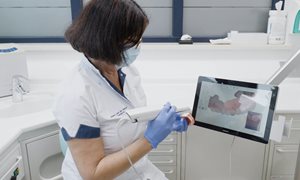

Innovative dentures supported by implants
Over 2 million people in the Netherlands wear dentures. Over time, dentures can become loose and painful. At Radboudumc, a new method has been developed: 3D snap-on dentures that are clicked onto implants.
read moreBenefits
- less dentist appointments
- more accurate
- more sustainable
- space for your input
- less labour-intensive
- less materials and costs
More information

Timeline 3D snap-on dentures
This method doesn't just save time and money, it creates more room for patient participation by using the design app. View the steps of this method here.
read moreTimeline 3D snap-on dentures
If denturesstart to become loose, the dentist may recommend implants. A scan will be taken to determine if there is sufficient jawbone for implants. A bone deficiency may first be supplemented by the oral and maxillofacial surgeon. For a toothless patient with a shrunken jaw, this is generally covered by health insurance (in the Netherlands). This also applies when teeth, including bone-bearing parts, have been lost due to an accident.
Implants
Dental implants are titanium screws to which a crown or bridge can be attached. Implants take 2 to 6 months to "grow in," depending on the bone quality. If the jawbone needs to be replenished first, a period of 4 to 6 months is added.
Design
- A light photograph is taken. The new teeth are drawn in using the software 'Smile Design'. The patient can study the picture and determine the desired shape, color, and position of the teeth.
- The patient can review the design at home using the specially developed app for cell phones.
- A camera the size of a toothbrush is used to take pictures of the implant positions in the mouth. Combined with images of the old dentures, these form the basis for the digital design of the new snap-on dentures.
- In the laboratory, the click dentures are digitally designed. Even then, each tooth can be moved and adjusted individually.
- A fitting prosthesis is made in the color of the future teeth. This is used to see if the teeth 'fit together' properly. The patient can still make changes to the teeth at this point as well. Any adjustments are made directly on the fitting prosthesis.
Tailoring
When the design is final, the individual parts are made. The pink base and the teeth are milled separately and then joined together.
The snap-on dentures are then finished. Of course we check with the patient whether everything fits well.

5 questions for Gert Meijer
Gert Meijer is a professor of Implantology at Radboudumc. Gert developed the concept for the digital 3D snap-on dentures together with Frans Delfos, head of the dental laboratory, and Luc Verhamme, senior staff member of the 3D lab.
read more5 questions for Gert Meijer
#1 What will 3D snap-on dentures bring to dentists across the world?
'Until now, the 'old-fashioned' click dentures have been made by hand. This is done by a dental technician, by placing artificial teeth in a wax model and then heating the wax. This allows it to be properly shaped. This 'setting up' takes a lot of time for the dental technician. Only when the position of the teeth is approved is the denture actually pressed. The subsequent hardening also takes a long time.
The digital method only works with computers, both to design and to actually make the 3D snap-on dentures. The design is also stored so that if the 3D snap-on dentures are lost, new ones can be made immediately. Eventually every dentist will use this digital technique. It does require the necessary flexibility on the part of the dentist to change working methods! But above all, it will save them a lot of time, both for themselves and for the patient. In addition, all patient appointments can take place in the dental practice itself.
#2 3D snap-on dentures are more sustainable than regular snap-on dentures, how?
'In the 'old-fashioned' method, for example, the plastic is touched up with a drill. In the process, coastal plastic particles are released. The sustainability of the 3D click denture is in the limited use of materials and the avoidance of the toxic monomers.'
#3 Is that why the lab technicians in the video do not wear a white coat and face protection?
Because of the contamination by monomers and flying plastic particles, the dental technician first had to wear special clothing and a mouth mask. The fabrication of 3D snap-on dentures takes place in a closed environment; the clickable denture is milled out in a kind of sealed cabinet. The plastic particles that are released are sucked directly into the cabinet. This makes special work clothes and masks superfluous in the work area (which is also much more sustainable, of course).
#4 What does this mean in the long run?
'The 3D snap-on dentures are produced in an environmentally friendly way, the digital design remains available at all times, and its fabrication takes only three clinical session. The digital design process so far is three times faster than the 'old-fashioned' method using a pressed wax model.'
#5 What is your dream for 3D snap-on dentures?
'My dream is that this digital technology will be embraced by dentists and patients alike. In addition to being green, digital fabrication also delivers a better product. The final finished product is extremely strong and therefore 3D dentures can be 'slim'. The final cost will halve. This would allow insurance companies to treat twice as many patients with the same budget. As a result, implantology becomes cheaper and thus more accessible to the patient!'
Our team




